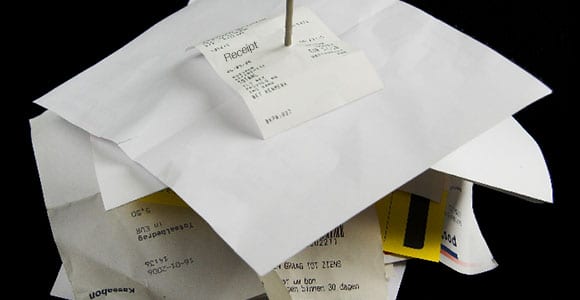
General Rules for Good Organization
All artists should keep track of their expenses. They are deductible and will save on taxes!
Keeping track of expenses should be made a priority. If the artist says instead that he will work on the expenses when he has time, that time will never develop. Develop a habit. Set aside a certain number of hours per week or a day per month to do your administration and accounting.
The artist has to multi-task and be organized as he is running a one-person business.
The Well Organized Workspace
 Kurt uses two bulletin boards.
Kurt uses two bulletin boards.
- One is a gallery board. He provides a spot on the board for each gallery where he is exhibiting. He attaches prints or 4×6 photos of paintings he has in the gallery. He includes the size, title, and price on the back of the photos.
- On another bulletin board he attaches announcements and prospectuses for invitational shows. He posts workshops, shows and mailings that are pending.
Inbox Files
A separate file box is set up by Kurt for each type of accounting activity. They are labeled “To Do”, “Receipts and Statements”, “Address Updates”, and “To File”. He uses an accordion file for the receipts and statements.
Art Income and Expense the IRS Way
 Records should be maintained in such a way that they can be easily recorded on income tax forms. Kurt uses two files..one for “entered” and the other for “not entered”. He uses the accounting program “Quicken”.
Records should be maintained in such a way that they can be easily recorded on income tax forms. Kurt uses two files..one for “entered” and the other for “not entered”. He uses the accounting program “Quicken”.
| BUSINESS EXPENSE WORKSHEET: | ||
| Art Income: | This is separated between Form 1099 Income and Non-1099 Income. | |
| Supplies: | Includes office supplies, postage stamps. It is not necessary to keep an inventory for Schedule C. All materials should be posted to “Supplies”. | |
| Communications: | Internet, Biz and Telephone, Biz. | |
| Advertising: | Printing and Reproduction Ads |
|
| Travel: | ||
| Meals & Entertainment: | Divide between 50% (travel. Only category that is not a dollar for dollar expense for IRS) and 100% (company parties) | |
| Legal & Professional Fees: | Includes dues | |
| Contract Labor: | Models, limited services | |
| Misc. Expense: | Postage & Delivery Subscriptions. |
|
| HOME OFFICE EXPENSE WORKSHEET:This provides information for determining percentage use of certain expenses which may be deducted for IRS. | ||
| Maintenance & Repairs: | House and studio | |
| Utilities: | Gas and Electricity | |
| Improvements: | Studio only | |
VEHICLE EXPENSE:Either of two methods may be used. The artist should keep track of miles driven in the car for each place he goes and record which are for art purposes. At the end of the year he should add up the total art miles.
|
Non-Business IRS Records
In order to prepare the IRS income tax records, it is necessary to keep track of a number of non-art income and expense items.
- Spouse’s W-2
- Interest Income (from form 1099-int)
- Dependent Care Expense (separated by provider. Need his EIN or SSN.) These expenses should be separated by each dependent.
- Donations and Tax Credits (donation receipts, private schools (scholarship organization), public schools)
- During audience discussion of “Donations” involving artwork, it was suggested that if the artist has received a check from an auction and then writes a check for the commission, the commission m ay be listed as a contribution to the sponsoring organization. Another suggested option was that an artist could swap a painting with another artist and donate it, thereby being enabled to take a deduction for the full amount of the value.
- Homeowner’s Expense (Property Tax, Homeowner’s Insurance, Mortgage Interest (form 1098)
- Auto Registration Fees (artist’s car and spouse’s car)
- Medical Expenses. (All receipts added by category of Prescriptions, Medical Professional Fees including Dental, Eyewear and Eye Exams and Health Insurance)
- Quarterly Estimated Tax Payments are normally required for an artist.
Methodology for Maintaining Records
 Several package programs are available for maintaining accounting records such as Turbo Tax Online or Quicken. Kurt enters all cash expenses as well as check and credit card expenses. Downloads may be made from online banking and credit cards to Quicken
Several package programs are available for maintaining accounting records such as Turbo Tax Online or Quicken. Kurt enters all cash expenses as well as check and credit card expenses. Downloads may be made from online banking and credit cards to Quicken
Income and expenses may also be recorded in a spreadsheet. At the end of the year, data can be transferred from Quicken to an Excel spreadsheet.
Keep an inventory of art. (See “The Well Organized Workspace” above). While not needed for IRS, it is essential that the artist keep an accurate inventory of available work.
Maintain good Gallery and Customer Relations.
Have a website and keep it updated continuously with new work.
Make a Business Plan. Have one for One Year, Five Years and Ten Years.
Check List for your Administration Day:
- Update Email – respond/file
- Update Inboxes – To Do, Receipts & Statements, Address Updates, To File
- Update Calendar
- Update Bulletin Board
- Update Gallery Board. Contact Galleries.
- Update Organizer
- Update Spreadsheet Program. Download Bank/Credit Card Data. Check against Receipts/Cleanup
- Update Website
- Review and Update Business Plan